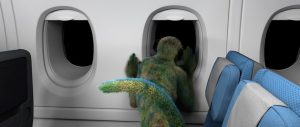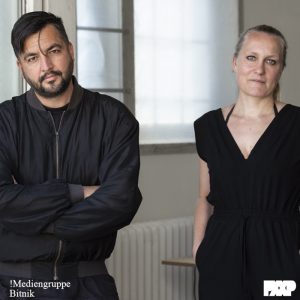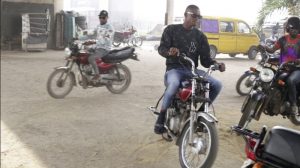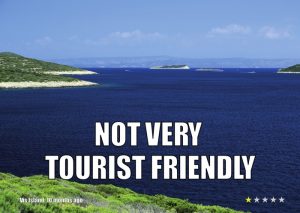One of the artists whose work i was most happy to discover at the exhibition Alter Nature: We Can in Hasselt a few days ago is Antti Laitinen.
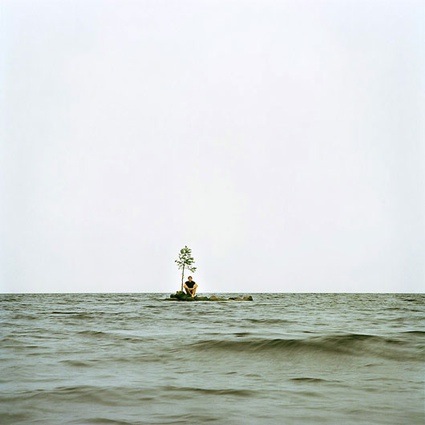 It’s My Island VI, 2007
It’s My Island VI, 2007
The young Finish talent fills one room of the art space with a video triptych and a series of photos from It’s My Island. The work documents Laitinen’s sisyphean attempt to build his own island (and therefore micro-nation) in the Baltic Sea. He is seen filling hundreds of bags with sand, dragging them to the sea amidst relentless waves and conditions, until the island starts to emerge above the water surface.
The idyllic landscape took 3 months to shape up. Large storms reduced it to nothing in next to no time.
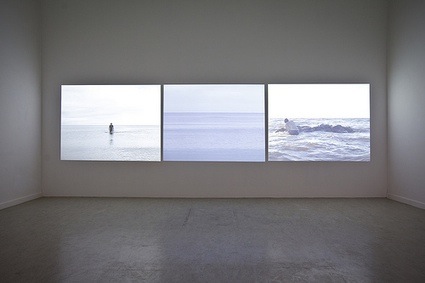 It’s my Island, 2007. Photo: Kristof Vrancken / Z33
It’s my Island, 2007. Photo: Kristof Vrancken / Z33
A year after, Laitinen embarked on Voyage. He constructed yet another paradise island complete with a little palm tree and a white beach, except that this one was not anchored anywhere. There’s more, he rowed it through the Baltic Sea, in Greece and on the Thames in London.
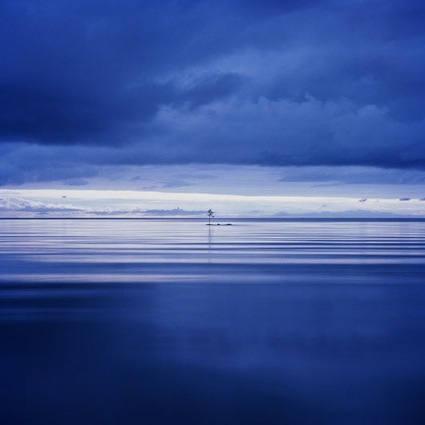 It’s My Island I, 2007
It’s My Island I, 2007
Laitinen, i thought, was perfect material for a short interview on the blog:
It’s My Island documents your quest to build a paradise island in the Baltic Sea. Did you take some time to enjoy your own little territory between the moment it was built and the day it was destroyed by a storm? Or was the 3 month long construction process what mattered most to you?
Were other people interested in visiting your island?
The whole project took 3 months. Half of the time I was building it and during the other half I was taking photos of the island. In this half I also had to repair it every time a storm destroyed it.
It was quite a small island so after it was ready I wasn’t there much but lots of ducks often came to rest on the island.
When the island was ready I invited some of my friends to visit it. It was kind of the opening of my island. There were around 15 of us at the same time.
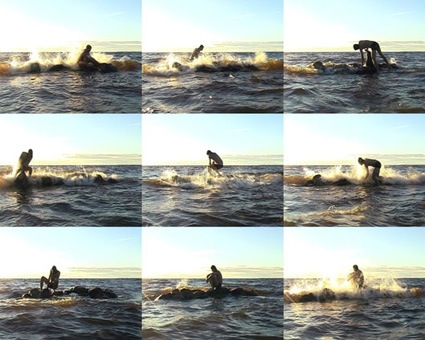 It’s My Island I, II & III, 2008. Stills from the video triptych
It’s My Island I, II & III, 2008. Stills from the video triptych
Voyage is quite different. You are still building an island but this time it’s a traveling one. Are you exploring nomadism rather than territoriality with this series of performances?
Voyage is a little bit of both. It is fantasy that you have your own island but you are free to go where ever you like.
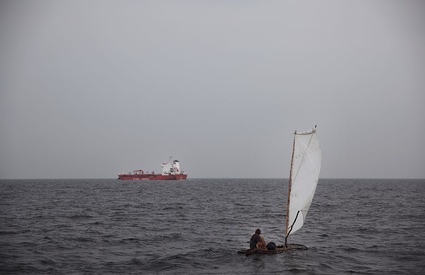 Bark boat, 2009. Antti Laitinen sails across the Gulf of Finland to Estonian coast. Photo: Juuso Westerlund for Curated Expedition to the Baltic Sea
Bark boat, 2009. Antti Laitinen sails across the Gulf of Finland to Estonian coast. Photo: Juuso Westerlund for Curated Expedition to the Baltic Sea
I was also interested in the fact that you chose to use bark to build some of your vessels. Is there any reason for that?
We have lots of pine trees in Finland. Almost every Finnish person has built small bark boat when they were children. They took piece of bark and carved it in the shape of a small sailing boat.
I wanted to make a larger bark boat which I could really use. When it was ready I sailed with that across the Baltic sea.
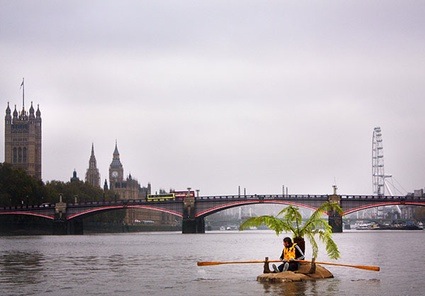 Voyage, 2008. Performance on the Thames, London
Voyage, 2008. Performance on the Thames, London
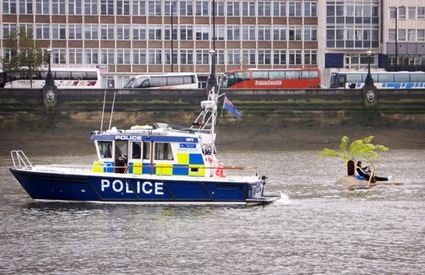 Voyage, 2008. Performance on the Thames, London
Voyage, 2008. Performance on the Thames, London
Micronations such as the Principality of Sealand struggle to be officially recognized, this sometimes leads to diplomatic clashes with surrounding nations. Is that something you’ve experienced while sailing on the Thames, the Mersey River or anywhere else? i read in particular that you were almost arrested by the London police? Can you explain us what happened and if you had similar experiences anywhere else?
I rowed my palm island down the Thames with the aim of rowing through the centre of London. After a few kilometres of rowing the police pulled me over in front of MI5 and stopped my performance. They asked me if I knew what building I was beside and I said ‘yes, that’s along were I am going.’ They didn’t agree, and towed my island and me back up river.
One year later, the police stopped my performance in Athens when I was building an island using small stones. Because we didn’t speak the same language, I couldn’t understand what the problem was. Anyhow, the police went away after a while and I could continue my project.
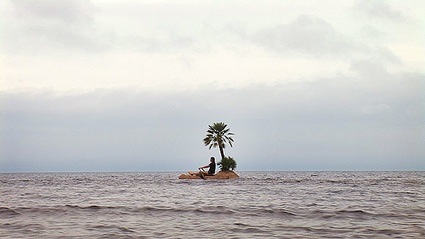 Voyage, 2008. Still from the video
Voyage, 2008. Still from the video
Once your island is launched on the sea or river, you are at the mercy of the weather and other natural elements. Things could go wrong. How much external support do you have? Or are you relying on your own strengths?
I want to do things as independently as possible but I do not want to compromise my safety. My water vessels are not so seaworthy so sometimes I have a safety boat nearby if there is the risk that something could go wrong.
You took your islands and vessels on the Baltic sea but also on rivers. Is the way you approach the open sea very different from the way you prepare yourself for a trip on a (i assume) easier to control river?
A river is a lot busier than the sea. A small area has a lot of traffic. For this reason, it is difficult to obtain a permission to put your vessel onto river and if you go there without permission then the police might stop you.
On the sea a bigger problem is the weather. A storm can arise rapidly. The situation can be dangerous even if you have safety boat.
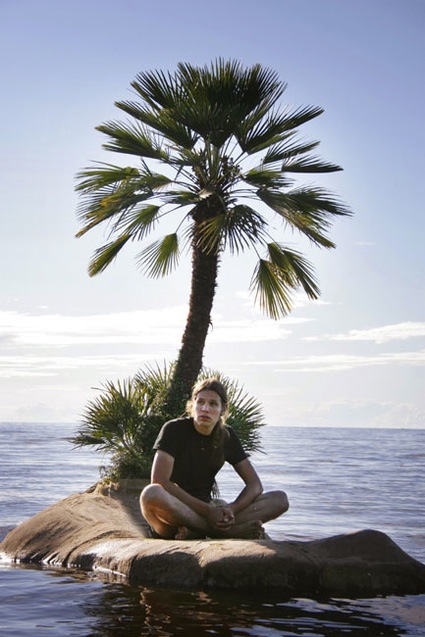 Voyage, 2008
Voyage, 2008
Thanks Antti!
Curated by Karen Verschooren, Alter Nature: We Can remains open until March 13 at Z33 in Hasselt, Belgium.
Previous posts about the exhibition Alter Nature: The flying tree and Alter Nature: We Can.


